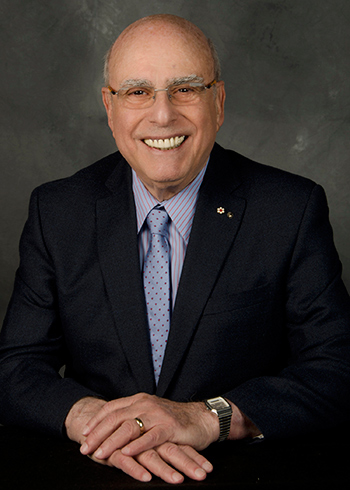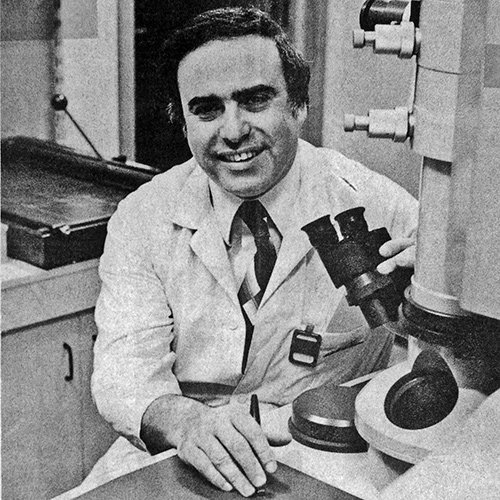Montreal's gift to the world
A major preoccupation for cancer researchers in the early 1960’s was the search for a specific biomarker, material or molecule, that would distinguish tumour cells from regular cells – in essence, a way to identify cancer through a simple blood test. “Numerous attempts had been made, but none had been successful. The common wisdom at the time was that such a marker would not be found,” said Dr. Phil Gold, the Douglas G. Cameron Professor of Medicine at McGill University, the first Director of the Goodman Cancer Centre, and former Chair of the McGill Department of Medicine. “For myself and my then PhD supervisor Dr. Samuel Freedman, it sounded like a challenge we were happy to accept.”

Dr. Phil Gold
After completing his first year of residency at the Montreal General Hospital, Dr. Gold worked on his PhD in the laboratory of Dr. Freedman, who was the director of the Division of Allergy at the Montreal General Hospital and subsequently dean of medicine at McGill University. In 1965 they published their discovery of the carcinoembryonic antigen (CEA), which is produced during the growth of the bowel. Subsequent studies led to the development the CEA blood test - the first blood test approved, internationally, for the detection and management of human cancer. At lot has changed in the past five decades, but the CEA test remains the most frequently used blood test in oncology around the world today. This year marks the 50th anniversary of this breakthrough discovery by the two researchers, and Dr. Gold shares some of his memories of the groundbreaking discovery that was truly Montreal's gift to the world.
The research utilized a few new and unique ideas: “We employed immunologic technologies, which had not been used in cancer research at that time,” recalled Dr. Gold. “We focused on rabbits because they are good producers of antibodies, and we used colon tumours because they grow differently from other tumours making it easier to compare the tumour tissue with normal tissue which was taken from the same individual. ” By utilizing two different approaches to the preparation of antibodies against the tumour tissue, the researchers were able to completely eliminate any other explanations for normal components in the tumour tissue meaning that any response by the rabbit would have to be the colon tumour biomarker, named CEA.
The “eureka” moment came when the newborn rabbits’ were made immunologically tolerant (unresponsive) to normal colon tissue to which they were exposed at birth andwere later injected with cancerous cells from the same individual. The rabbits responded to the molecule in the cancer tissue that had been produced when the tissue became cancerous. This identified the cancer molecule, which was subsequently found in human embryonic digestive organs, as well as in cancer, leading to the designation of CEA.
“The discovery of CEA was significant because it was the first time that a tumour biomarker had been clearly demonstrated to exist, even though very small amounts of CEA were also present in normal tissue,” explained Dr. Gold. “Therefore, we were able to establish a blood test that allowed us to examine the blood samples of individuals with a variety of different conditions to see if this would be helpful in the diagnosis, management, and treatment of cancer patients.”
After a good deal of work in the field, involving laboratories from around the world, it was demonstrated that CEA is present in elevated and increasing concentrations in 70 per cent of all human cancers. The blood test for CEA was the first blood test for cancer sanctioned by the Food and Drug Administration (FDA) in the United States, and then by virtually every country in the world.
Dr. Alan Barkun, Director of Therapeutic Digestive Endoscopy and Quality in the Division of Gastroenterology at the MUHC highlights the importance of this discovery: “The CEA test is the standard against which other human tumour markers are measured. It is presently the most common blood test for cancer, 50 years down the road from the time that it was discovered,” he said. “Various cancer organizations across the world have established that the blood test for CEA is instrumental in predicting the future outcome and monitor the management of the disease in patients with colon cancer. This discovery has helped shape the modern era of cancer immunology and tumour markers.”

Dr. Phil Gold in 1970 at the University Medical Clinic Labs at the Montreal General Hospital.
Dr. Gold’s distinguished career has earned him an induction to the Canadian Medical Hall of Fame, an appointment as an Officer of l’Ordre National du Québec as well as a Companion of the Order of Canada amongst other coveted awards. When asked about the future of cancer, Dr. Gold is optimistic. “I have no doubt that a variety of cures for cancer will be forthcoming. Indeed, many are already in place and such conditions as Hodgkin’s disease and Chronic Myelogenous Leukemia are now virtually curable,” he said. “In addition, many other common cancers such as those of the bowel, breast, and even lung, are now being treated with ever increasing success.”
Dr. Gold and Dr. Freedman, and the 50th anniversary of the discovery of the CEA, was celebrated at a scientific symposium on Tuesday, November 24, 2015. Dr. Gold, who was one of the speakers addressed a full house made up ofhealth care workers, researchers, and the general public.
